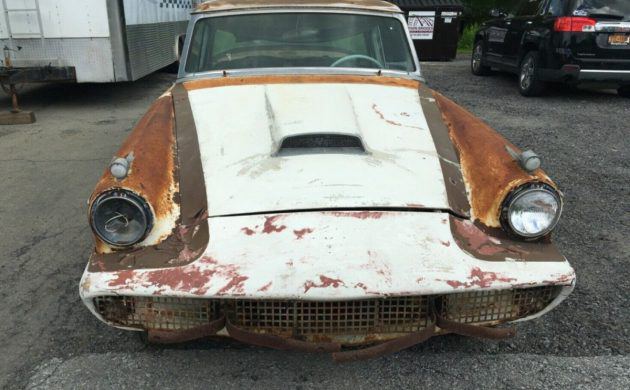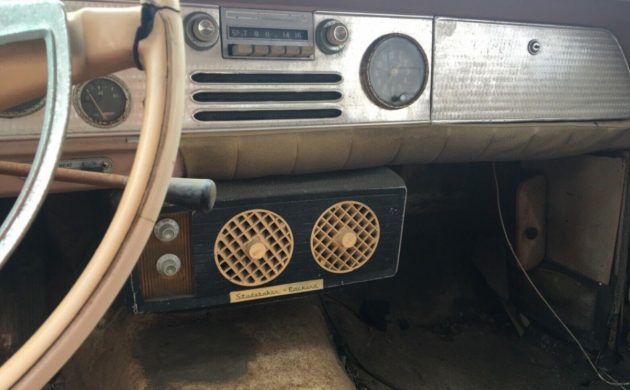After the merger of Studebaker and Packard in 1954, both brands continued to struggle for customers, especially Packard. The 1956 models would be the last built specifically by Packard, with the 1957-58 cars being rebadged Studebakers for the most part. The 1958 Packard Hawk was the last “new” car introduced under the Packard name with the brand withdrawing from the market after that. The front clip of the Packard Hawk was different from its Studebaker counterpart, but that didn’t help generate interest which stopped at 588 cars for the year. This ’58 Packard Hawk, a rolling project, is in Galway, New York and available here on eBay for the Buy It Now price of $3,995 (or make offer).
Packard only fielded four models in 1958, all reworked Studebakers. The Packard Hawk was a Studebaker Golden Hawk with a fiberglass front end and modified deck lid using a supercharged 289 V8 engine. It was intended to compete with the Ford Thunderbird, which was totally new and now a 4-seater for ‘58. The Packard Hawk ditched the Studebaker’s Mercedes-style grille for a wide, low opening just above the front bumper that covered the full width of the car. That gave way to a smooth, sloping nose and hood with a bulge to accommodate the 275 hp engine. At the other end, the trunk lid used a fake spare-tire hump as Studebaker had done five years earlier.
The seller’s “Packardbaker” (as they were sometimes called) has spent the last 30 or so years in a barn. There’s a lot of surface rust all around, especially on the entire rear section of the car which suggests that part of it was exposed to more sun and rain. There are no gaping holes that we can see other than in the trunk floor and maybe on the hood, yet the floorboards seem solid as most of the interior is no longer there. The car is incomplete and what you see is what you get.
Also gone is the original engine and automatic transmission, which would have come from Studebaker as well. The car was set up for factory air conditioning, a rare option in a rare car, but only the inside hardware seems to have survived. So, in addition to funding a thorough restoration, a search for parts is also going to be part of the equation. Since fewer than 600 of these cars were built before Packard threw in the towel, this may be the rarest of the Hawk cars which saw a variety of incarnations between 1956-64.
The styling of the Packard Hawk was a bit controversial at the time. You either liked it or you didn’t. The front end was deemed a “vacuum cleaner” or “catfish” by its detractors. That styling and low production have combined to make them perhaps the most collectible Hawks today, which is why a Packard Hawk will usually go for more than its Studebaker companion. Hagerty estimates that a well-heeled survivor or restoration can fetch $60,000, but this example is far from there. Sourcing everything that is missing will not come cheap, and then there’s the cost of fixing the body and interior. But just how many of these automobiles can be left, having not been sent to the scrap heap years ago?







If ugly counts then this is your car. Real shame what Packard did to these cars. As I’ve said before, reincarnated a few cars in this condition but don’t think this car is worth the time and effort. After owning a ’53 it’s hard not to have a biased opinion on the Packardbaker.
The only line this ‘Packard’ should be in is the one at the junkyard crusher.
Not the junkyard crusher….. there’s still a few decent parts that could lend themselves to another Packardbaker.
True, the nose, hood and AC alone would probably bring a couple grand from a PH guy that really needed them. The front fenders too aren’t too bad. Those are hard to come by in condition as good as that. They aren’t the regular Stude Hawk fenders. In order to work with a PH nose, they’re modified at the front bottom.
Digging the marker lights on top of the fenders. Those were factory-issue or after-market? Hope some mother is out there to love this face again!
Fendertop lights were factory from ’56-’58. I think the ’58s had gold colored delta-dart-like wings added to them for extra pizazz. Shame the car is so deteriorated.
Quote: “At the other end, the trunk lid used a fake spare-tire hump as Studebaker had done five years earlier.”
I don’t recall Stude ever using a fake spare tire hump in ’53 or otherwise except on these Packard Hawks. The tire hump was a fixture of ’57-up Imperials, which I presume is where the idea came from for these cars.
Have seen two of these Hawks IRL. One at the old Harrah’s auto collection in the ’70s, the other at a repair shop in SoCal about 10 years ago. The missing tail fins on this one reveal its ’53 Studebaker roots.
It’s not only the front end which was fiberglass. Both the Studebaker and Packard Hawks had fiberglass fins which are missing here. It looks like someone already used this as a parts donor for another car. At least the shell only looks moderately rusty, not terminally so. I think the only future for this one is as a resto-mod, built up with parts from a rusted-out Studebaker.
Only the 56 Golden Hawk had fiberglass fin’s, all of the rest of them were steel fin’s.
I didn’t realize that. Thanks for clarifying.
If this isn’t ‘rusted out’ I don’t know what is!
I didn’t realize that. Thanks for clarifying.
The fins on the Packard Hawk are steel – I know, I own one. I believe that the only Hawk with fiberglass fins that S-P made was the 56 Golden Hawk. After that, they were steel.
The fiberglass fins were used on the ’56 Golden Hawk only. The fins on the ’57 and later years were steel. I know, while working on mine I had to remove them.
Sad ending for two great brands.
Does look better sans-fins and extraneous bling…
I have the spare tire cover on the trunk and a dash but that’s going in my 55 coup or I could buy the whole car except for tooooooo many projects now but still I like the idea of restoring it
Just too much missing from this Hawk. Plan on spending 80 plus for a restoration.
You better have had your tetanus shots before sitting in this rust bucket!
Ugliest… car… ever… which is a shame because the base body, the Lowey ’53, was a stunner. Studebaker used fiberglass panels to disguise “last year’s model” on cars & trucks in the mid to late 50’s… to no avail. My ’56 Transtar pick up has a fiberglass cover over the top of the dashboard to try & conceal the same dash as a ’49. The Hawks had steel bolt on fins and a different hood which worked visually for a while. The frames were the same for a ’49 as an Avanti, but because you couldn’t see it, few people knew. When Studebaker & Packard merged it was the death knell for both companies who were, at one time, “top of the heap”.
A sore sight for eyes. They should have named this model the ‘Catfish’. Loewy and the real designer, Bob something, must have rolled over in their graves with this design. Design 101 – how to ruin a beautiful design, aka car caricature.
Didn’t read the whole article before posting the Catfish moniker. Could also be a hammerhead shark. Unless you’re a Stude afficionado with a bunch of parts cars (I knew a guy near me who had 200 or so in a field…gone now mostly crushed), this would be a museum operation at best….IMO.
Since it had A/C it was not supercharged.
Vince H,
I agree that typically if A/C was ordered on a Studebaker, you couldn’t get both A/C and a supercharger.
But I’ve owned 2 Supercharger equipped Packabakers with factory A/C.
In 1970 to 1972 I had [as my everyday transportation] a 1957 Packard Clipper sedan with Factory A/C and the Supercharger. The cooling unit was in the trunk, and the belt driven A/C compressor was mounted way down on the right side of the engine.
In the late 1970s I owned a 1958 Packard Hawk. It had the supercharger and also factory A/C. What it didn’t have was power steering or power brakes! The compressor was mounted where the power steering pump would have been located.
I’ve contacted the owner of this car and asked him if his car was equipped with power steering or power brakes, as I can’t see from the photos if the car had either one. I will comment again once I’ve heard back from him.
I did note that the Vac/boost gauge is in the dash cluster. I’ve never seen a Golden Hawk without a factory equipped Supercharger, so I can’t say one way or the other if the car didn’t have a supercharger, it didn’t have the gauge either.
I glad to see you know your Packardbackers Bill, It needs some one like you to bring it back to its former glory!!
Bill I found a drawing showing A/C on Packard Hawk. It was mounted on the where the generator usually sat. The generator/PS pump was on the left. Yes it was supercharged.
I have never seen one. It must be super rare.
Just received latest issue of Turning Wheels. I has article about A/C on 57 Golden Hawk. It says 4 were built in the engineering department. None on the production line.
Vince, Thanks for the research. As my car was a very early version, I’m thinking there was perhaps several versions. Or perhaps my car had been ordered without power steering or brakes, and the fact it had A/C had no bearing on those options.
Looks like I’m gonna have to make a trip over to Delaware [not a big trip for me] to see the other A/C car.
None of the 588 1958 Packard Hawks were built without a supercharger. All of them were built with the McCulloch-supercharged 289. I think people often forget that you could get options like AC from the dealership, and if you knew the people at Studebaker well enough and were a special enough customer you could get a car built pretty much however you wanted it. After all, the Packard Hawk is not an actual Packard. It is a Studebaker Golden Hawk with some some that-model-only trim and body pieces and Packard badges.
And they say there’s no such thing as a unicorn! Sorely tempting, even with a massive scavenger hunt!
This would be a extremely difficult car to restore. Getting the missing parts would be nearly impossible. Unfortunately this car is from the darkest days of a brand that was one of the finest manufacturers in the history of the automotive industry . I just can’t see it being worth the effort.
Not the ugliest car ever, wasn’t there a model with 4 headlights? Now that was ugly.
This might make a good, vintage Bonneville project.
Bonneville tribute for the street.
What a great re-purpose of a unusual vehicle that might otherwise be lost to the public…
I think they are very good looking and this is a good solid car to restore! the rarity and asking price make it even better! Lets hope it is saved!!